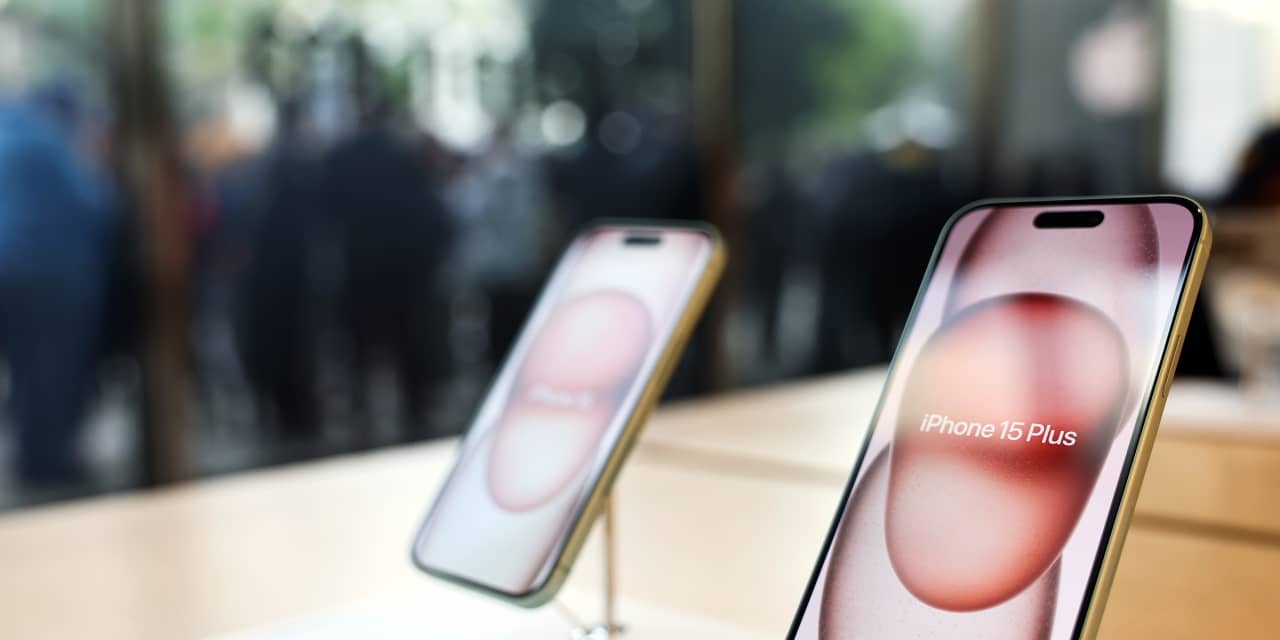Apple
reports financial results for the September quarter after the close of trading on Thursday, and all eyes will be on the progress of the company’s recently launched iPhone 15 smartphones. What the Street most wants from Apple is a reason for optimism that it can meaningfully break out of its recent malaise. Analysts expect revenues to decline from the year-ago level for a fourth straight quarter.
In particular, the Street will be straining their collective ears for signs of optimism about the company’s all-important December quarter. But there are reasons for worry. Apple (ticker: AAPL) faces growing competition for the iPhone in China from the Huawei Mate 60 Pro smartphone; there are concerns about tightening U.S. consumer spending; and lingering reports that iPhone 15 faces both lackluster demand and ongoing component shortages.
While Apple shares have appreciated 30% this year, the stock is off 13% since it reported June quarter results, amid worries about the lack of growth and mixed reports on demand for the iPhone 15. If the stock declines appreciably on the earnings report, Apple could be dethroned from its position as the market’s largest company by market cap by
Microsoft
(MSFT), which is up 40% this year, driven by investor enthusiasm for its AI software push.
Morgan Stanley analyst Erik Woodring wrote in a research note previewing the quarter that while September quarter results could beat estimates, there is a risk that December quarter commentary could be below consensus, “creating a tactically cautious setup.” Woordring writes that he worries that the holiday quarter could be affected by “iPhone supply shortages and uneven consumer spending,” which he thinks could lead to “a revenue range that is both below normal seasonality and consensus expectations.”
Jefferies analyst Andrew Uerkwitz says he will be looking for comments from Apple on China market share and product replacement cycles. “Our fear is we could slowly return to replacement cycles similar to pre-COVID or even longer as consumers underappreciate faster chip speeds, battery life, and display quality as current products are ‘good enough’,” he writes.
Street consensus estimates as tracked by
FactSet
call for September quarter revenue of $89.3 billion, down about 1% from the year ago quarter. Profits are expected to be $1.39 a share, which would be up a dime from a year earlier.
On the company’s last earnings call, CFO Luca Maestri said that September quarter revenue would show a decline comparable to the 1% dip in the June quarter. He also said that iPhone and Services revenue would accelerate from the June quarter, but that both Mac and iPad sales would be down double-digits from the year ago-quarter. Maestri projected gross margin in the quarter of 44% to 45%.
Consensus estimates call for iPhone revenue of $43.8 billion, up 2.7%, improving from a 2.4% decline in the June quarter. Estimates call for iPad revenue of $6.2 billion, down 13.4% from a year ago, the 7th year-over-year iPad sales decline in the last eight quarters. Likewise, the Street sees Mac revenue in the quarter off 5.8%, to $8.5 billion—that’s four declining quarters in a row, and five out of the last six.
For the wearables, home and accessories category, estimates call for revenue of $9.5 billion, down 1.9%. Services revenue is projected to be $21.4 billion, up 11.4%, rebounding from four straight quarters of single digit growth.
For the September 2023 fiscal year, the consensus calls for revenue of $382.9 billion, down 3% from FY 2022, with profits of $6.06 a share, down from $6.11 last year.
For the December quarter, consensus estimates project revenue of $123.1 billion, up 5%, with profits of $2.09 a share. That includes an expected 6% year-over-year improvement in iPhone revenue to nearly $70 million, with the services category projected to grow 10% to nearly $23 billion.
On Monday, Apple held an unusual 30-minute evening launch event to unveil a new line of Mac processors – the M3—as well as updates to the MacBook Pro and iMac hardware lineup. But the Street found the upgrades to be more evolutionary than revolutionary, and the unusual timing—5 p.m. Pacific time—was greeted as an annoyance. The Street also found the timing – just a few days ahead of earnings – to be unusual.
“The most irritated incoming calls we took last night were from money managers who now believe (tongue in cheek) that Apple hates families because they forced folks to leave the dinner table (or homework duties) to listen to their prerecorded event,” Needham analyst Laura Martin wrote in a research note about the event. “The odd timing, just 3 days before earnings, causes us to worry that laptop and iMac sales were weak in the September quarter. That would suggest that [the] launch was a way to mitigate any negative share price reaction, because Apple can focus on the future and reiterate how optimistic it is about unit sales of its new laptops and iMac products.”
Write to Eric J. Savitz at [email protected]
Read the full article here





